In just under 5 weeks time, I am moving back home, which is really hard to fathom.
While there are plenty of reasons why I should be ready to leave Mauritius, the prospect of leaving fills me with a certain sadness. For starters, there's the matter of all the things I will be leaving behind.
First and foremost, I will miss my friends. The few close friends that I have made here are really unforgettable. Ranging in age from 18 to 58, my group of friends counts among its members my constant companion Dorian, the researchers at my NGO, the university students aiding me with my project, my wonderful neighbors, a published novelist, a 30 year old doctor who studied at BeiDa, my Muslim friend who takes me out for drinks and dancing every Friday, my posee of a dozen or so gay and lesbian Mauritians (including one Catholic priest-turned LGBT activist) and a small cadre of progressive female lawyers.
Secondly, I will miss the food. As a wheat free vegetarian here in Mauritius, I have feasted like royalty for next to nothing. Vegetarian food is cheap, abundant, and incredibly creative. In fact, I hit up the veg-friendly eatery in Quatre Bornes so often, I have become friends with all of the servers and owners, and on my birthday, they even gave me a present, albeit a strange one.
There is also a robust culture of food vending on the street. My favorite roadside snack is a dish called gateaux piment, which is yellow dal soaked and blended with garlic and green onions and then fried. The final product is this heavenly meat-ball shaped that is typically eaten in chili.
There are also men that cook chinese dimsum and noodles on the road, and that serve roti with rougaille, pea curry, and seasoned spinach offered as toppings.
Apart from friends and food, I have also enjoyed the idiosyncrasies of the island that don't touch on the side of mistreatment of women. For instance, motorcycles are widely popular here, and on a given afternoon you can see "gangs" of motorcyclists idling at stop lights. However, breaking away from the typical dynamic, many of the Island's motorcyclists are men in their 50's, who use their motos as their primary mode of transit/transport/commerce. Thus, its not uncommon to see motorcyclists maneuvering the streets with hulking bags and oblong boxes or large potted house-plants.
And then there's Creole. Creole was initially the bane of my existence because it made communicating in French and English difficult... however, now I see it as a language that has a great deal of integrity at the level of grammar, and one that erases social distance and breeds a certain intimacy.
Finally, I will miss my fabulous rental house, my 6 remaining cats, my yard full of fruit tress, and the windows that look out onto the mountains...
Not to mention my sub-200 rent. Just received my housing offer from my Law School, and it looks as though I will be paying 6 times that amount to live in a studio the size of my current living room. Yay Manhattan prices!
Alas, now that I'm confronting the fact that I am on my way out, I have3 new commitments:
1. A Commitment to visiting all of the tourist attractions I've some how missed out on (MOST, as it turns out)
2. A Commitment to blog with more frequency &
3. A Commitment to send out postcards at long last.
Thus, to my readers:
If any of you would like to receive a post card from Mauritius, write me a comment with your mailing address in the body. All comments will be screened upon receipt to protect your internet anonymity
Labels: goodbyes, things that make me happy




